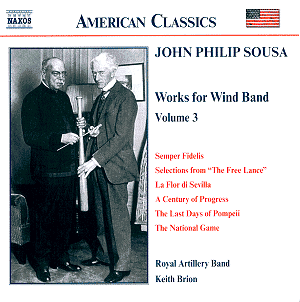There was a time back in the early 1900s when wind
band music was very popular and John Philip Sousa was the king
of the marching bands. Although that era is behind us, wind band
music continues to maintain an important niche in the musical
affairs of most of the world’s nations as attested to by the huge
number of wind bands in schools and military units. The music’s
heroism, exuberance, and patriotic nature stir the hearts of a
citizenry quite unlike any other musical category.
Most folks are probably unaware that Sousa wrote
more than just march band music; there were broadway musicals,
dance music, and even some softly projected and poignant pieces.
Naxos, now up to the Volume 3 of its complete Sousa wind band
music series, has been providing a fine mix of his different musical
forms. The approach, which also incorporates music from different
time periods on each disc, ensures maximum variety and contrast.
Volume 3 begins with two marches, the "Semper
Fidelis" being one of Sousa’s most popular marches and his
personal favorite. Named after the U.S. Marine Corps motto which
translates as "Always Faithful", the work soon became
the official march of the Marines.
The selections from Sousa’s musical "The
Free Lance" are quite revealing of the variety of Sousa’s
wind band music. Also, the musical is a delightful farce about
a man who assumes leadership of two warring countries, making
sure that neither side wins. The music is witty and often poignant,
proving that wind bands can do more than exuberantly march around
on a field.
Next on the program is the bustling "The
New York Hippodrome". There actually was a Hippodrome Theatre,
the predecessor of the Radio City Music Hall. Sousa and his band
often played there, and it was also the location of the Sousa
Band offices.
Sousa dedicated "La Flor di Sevilla"
to the Spanish people for the 1929 Ibero-American Exposition,
but there is little in it that would remind the listener of Spain.
Let’s just say that the piece is vintage Sousa.
"El Capitan" was a highly successful
Broadway musical that had a run of about four years in the United
States and Canada. In the selections on the disc, we are offered
a series of captivating waltzes. I’m not much of a dancer, but
I can’t keep still while listening. The 7th Track,
"A Century of Progress", was one of the last marches
Sousa composed and he passed away prior to its first public performance.
"The Last Days of Pompeii" is a three-movement
suite that Sousa considered his best piece of music. The first
movement conveys the great strength of the Roman Empire, and Sousa
injects a big-hearted joviality to the proceedings. In the second
movement, the tone changes to one of introspection and warmth;
the melodies are magnetic and highly comforting. The third movement
depicts the eruption of Vesuvius and the end of Pompeii and its
inhabitants. I advise listeners to be ready to adjust the volume
control downward. I didn’t do so, and my eardrums still feel traumatized.
Next up is "The White Rose" where Sousa
borrowed the basic melodies from C.C. Frick’s opera "Nittaunis".
This is a wonderful piece of music – great fun and zest for life.
The 1912 "With Pleasure-Dance Hilarious", has a ragtime
rhythm and continues the good cheer from the previous track. Sousa
had to endure some criticism of his march "The Belle of Chicago".
He dedicated it to the "ladies of Chicago", but complainers
felt that he made Chicago women sound hefty and utilitarian. The
program ends with "The National Game" which is a tribute
to major league baseball. Of course, baseball is no longer the
USA’s national game. If Sousa were alive today, he would likely
write a tribute to the National Football League and throw in some
head-concussion passages.
I am fairly enthusiastic about the performances,
my sole reservation being that a little more rhythmic snap would
have been favorable. However, the sound is strong and full, Brion
excels in the quieter pieces, and the price is right. Those collecting
this series have no reason to stop, and new entrants to Sousa’s
music should find Volume 3 a most enjoyable release.
Don Satz
